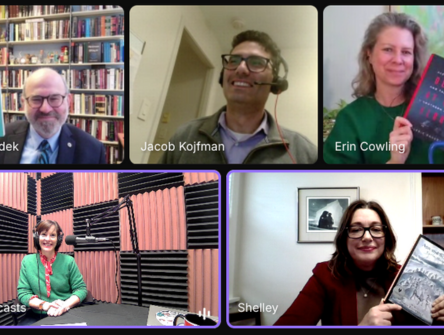How big data can give you a competitive edge
Law firms willing to make the investment can use legal analytics to add value for clients.

How do you stand out against competition? What if you could show new clients how your rate of success in the courtroom compares to other firms?
Legal data analytics offer a way. The massive amounts of data being collected in and outside law firms is creating opportunities to gain new insights about business and clients, measure success, solve complex problems and help clients reduce risks.
There are privacy concerns, and the legal community has been slow to take advantage of legal data analytics; it requires an investment in technology and dedicated personnel. But some observers see a lot of potential.
“For example, employment and compliance lawyers could analyze corporate data, correlate them with current legal costs, and potentially spot opportunities to change operations to avoid legal problems,” says Ron Friedmann, senior consultant for legal management consultants Fireman and Company. “That’s the future.”
Data analytics involve examining collected data to gain new insight about the information. For example, U.S. companies such as TyMetrix and Sky Analytics examine thousands of legal invoices to help legal departments compare prices and determine the best rates.
In fact, most analytics firms focus on legal billing and haven’t branched out to other areas such as litigation and corporate law. Lack of awareness, general apathy and few market pressures have contributed to slow growth.
“There’s lots of untapped potential because e-billing technology has mainly been used for rule-based analysis, for example, only one lawyer at a deposition,” says Friedmann. “That is not analytics. It’s not using the data to determine which outside counsel are most cost-effective.”
Other organizations have turned to analytics to solve complex issues. For example, faced with hefty settlement payments for failing to enforce a program to stop compulsive gamblers from entering casinos, the Ontario Lottery and Gaming Commission (OLG) considered a digital facial recognition system. The question was how to do it without breaching the privacy rights of everyone in the casino. Ann Cavoukian, former Ontario Privacy Commissioner and creator of Privacy by Design, helped them devise an innovative solution.
“There were two reasons why I didn't like [the proposed program],” she said.
“It would not only capture the picture of those asking to be kept out of the casinos, but everyone else as well.
“I also didn't want them to use a system of identifiable biometrics, meaning that the biometric could generate a biometric template or digital representation of the biometric. The police could easily read this identifiable biometric template if they had a warrant.”
She recommended using a biometric encryption where the facial images of self-excluded gamblers would be accessible, but in an encrypted form.
“Only the face of the individual involved could unlock the biometric on file. The biometric of recreational gamblers would not be captured since no match could be made to the facial images on file. It was a total win-win.”
Data analysis without tears
No law firm wants to become a Target, the giant retailer that suffered a major privacy breach last year resulting in the chief information officer’s resignation, nearly $150-million in expenses and a tarnished reputation.
But companies and law firms don’t have to let privacy concerns stop them from collecting and analyzing data. It’s still possible to do so safely while protecting the privacy of customers and clients.
Privacy by Design, a non-profit organization promoting data security, had a couple of suggestions in a recent report: data minimization, de-identification and restricting user access tools.
Data minimization shifts the focus to collecting only the data needed for the analysis instead of as much information as possible. Privacy tools should be embedded in data collection programs to request consent when it’s necessary to collect personal information.
De-identification of existing data is useful for managing data. Stripping data of personal identifiers means it can be analyzed and outsourced for multiple users. The Alberta government is currently de-identifying health information to make the data is available to researchers for analysis.
Any personally identifiable data should be de-identified before it’s used to perform data analytics, says Ann Cavoukian, former Ontario Privacy Commissioner and co-founder of Privacy by Design. The use of strong de-identification protocols significantly minimizes the risk of re-identification after the fact.
Privacy breeds innovation, she added.
“Companies gain a competitive advantage by giving customers the privacy they want. Privacy is both a consumer and business issue. Companies that treat privacy as a business issue gain a sustainable competitive advantage.”
Build your practice
What can you do with free data?
After taking some computer courses at the B.C. Institute of Technology, lawyer and former engineer Blake Wiggs decided to find out. The result is Patent Data Analytics, a website featuring everything from the location of patent filings in Canada and the United States to a breakdown of patents by classification.
“I’m not looking at evaluating patentability, but who is doing what,” said Wiggs, partner at Oyen, Wiggs, Green and Mutala LLP, a Vancouver-based IP firm. “Firms, IP rights owners and the patent office want to know that.”
He quickly figured out different ways to use the data.
For example, suppose a firm hires a recruiter to help it expand into a new area of technology and wants to give him or her direction about where to find that expertise. “By simultaneously searching patent technology classifications and patent firms’ names, you can see who might have the expertise you’re looking for,” he said.
Wiggs set up the website to share data with other lawyers and create data visualizations with Tableau Public, a free online program. Accessible, free data allows firms to experiment with different models and determine what will be useful for clients.
“If I could get all the data, I could do more,” he says. “The best example is the U.S. Patent Office. All their data is online. No other country has done that. I think Canadian Intellectual Property Office (CIPO) data should be public and all of it freely available.”
He advises starting out with data you’re familiar with so you can get a feel for whether the analysis is correct.
By the numbers
9,6 billion:
The number of devices in the world connected to the internet.
2.5 quintillion bytes (1018):
The amount of data created every day.
90%
Out of all the data in the world, the percentage created in the last two years.
51%
The amount of data in a structured format.
Five places to find open data
The open data movement is dedicated to free, accessible data to all people for all uses. Government agencies and major organizations are getting on board. Here are the top picks of open data websites:
• Canada’s Open Data Portal (www.data.gc.ca): This is the go-to destination for Canadian data from government agencies. Can’t find what you’re looking for? Suggest what new data sets should be released.
• Municipal open data sites: Halifax is the latest entry with the launch of halifaxopendata.ca and Calgary has revamped its website. Other open data cities include Toronto, Ottawa and Montreal.
• Google Public Data Explorer: Use this search engine for global data. Check out the eclectic daily charts.
• Open Science Data Cloud : The organization provides 700 terabytes of data used for scientific research.
• Statistics Canada: The well-known website is a good source for economic data. You can sign up for daily updates.
Advice from the experts
Blake Wiggs
Oyen, Wiggs, Green &
Mutala LLP
“We’re now in a highly competitive environment. Properly applied, data analytics can improve lawyers’ understanding of that environment and help them make adjustments to improve their competitive position.”


Ron Friedmann
Fireman & Company
“The framework today is we don’t know what we don’t know. To use Big Data effectively, we need R&D and no one is doing that. The law firms don’t have motivation to do that. The structure of the market is not there for law firms to be rewarded for giving a better product or service. They can, however, differentiate — but it’s difficult analysis and costly to try.”


Ann Cavoukian
Privacy by Design
“The likelihood of protecting privacy increases dramatically if you embed privacy measures into your program early on. I spoke to many engineers and computer scientists in what I called The Year of the Engineer to see if they could embed privacy directly into the code. They said ‘absolutely,’ provided that we are asked to do so right from the outset — along with the instructions given to write the program. Being asked to do this after the fact is not as effective; you can't just bolt-on solutions after the code has been written and expect good results. Privacy has to be part of the inception process.”



